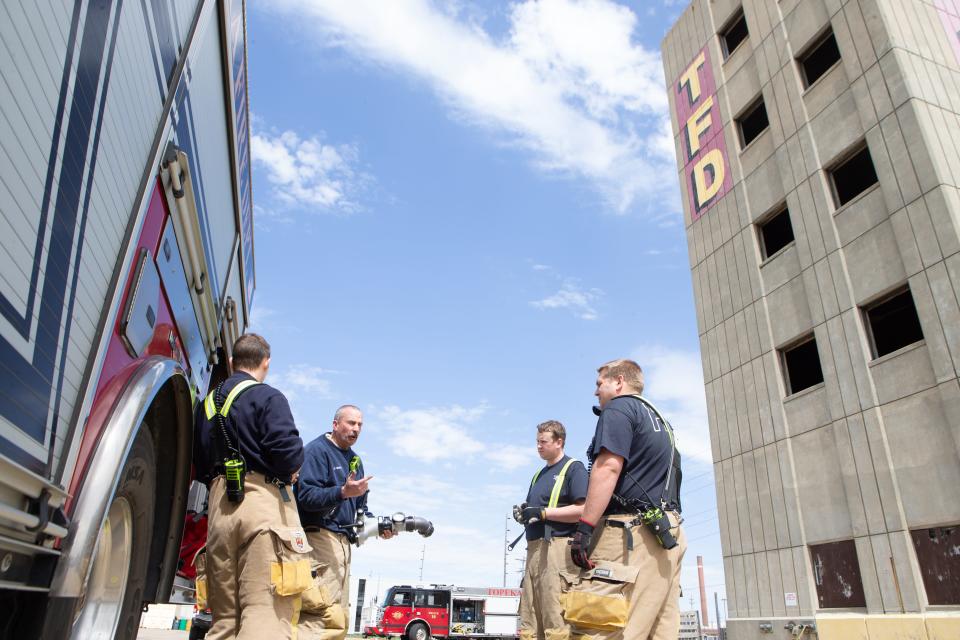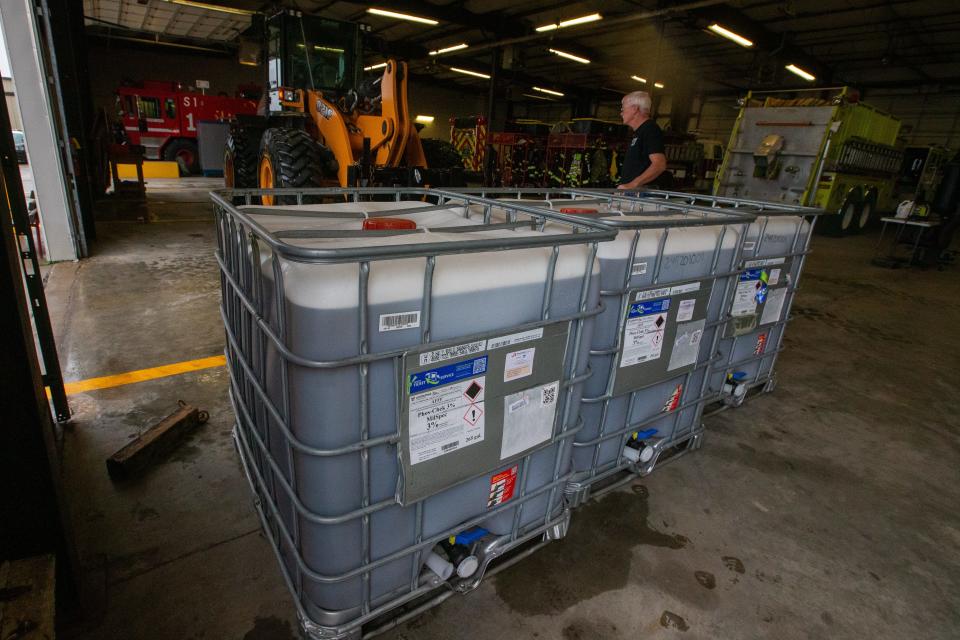PFAS, toxic 'forever chemicals', found in Topeka, but little testing is being done
Harmful and difficult-to-remove chemicals known as PFAS may contaminate the Topeka Fire Department facility featuring a training center at 324 S.E. Jefferson, said a 2019 Kansas Department of Health and Environment report.
Yet five years later, Topeka's city government still hasn't had that site tested, confirmed Rosie Nichols, co-interim communications director for the city.
When asked why it hasn't, Nichols said the city isn't required to do so.
The 2019 KDHE report, which tested wastewater but not drinking water, mentioned only the potential for PFAS in the city's wastewater, she added.
Topeka's city government isn't mandated to test wastewater for PFAs.

But the EPA is requiring the city next year to test its drinking water for such unregulated contaminants as PFAS under its Fifth Unregulated Contaminant Monitoring Rule (UCMR5), Nichols said.
"State regulatory agencies, in our case KDHE, set the sampling schedule for all their public water suppliers, including the city of Topeka," she said. "They have set up the UCMR5 testing for the entire state from 2022 to 2026 and ours is set for 2025."
'Forever chemicals': PFAS lurk in Midwest soil and drinking water, can lead to health problems
Once all sampling is completed and evaluated, new regulations could be put in place, Nichols said.
"Until the completion, we likely will not see any new regulations," she said.
What are PFAS?
Per- and polyfluorinated alkyl substances, or PFAS, are a group of nearly indestructible chemicals that build up in the human body over time. Known as "forever chemicals," they’ve been used widely for decades in nonstick and water-repellent household products, as well as industrial products.
PFAS could be a health hazard. They were found in more than one in four U.S. public drinking water systems last year in concentrations at or above the Environmental Protection Agency’s minimum reporting levels.
Places where PFAS has been detected include firefighting training centers, said Abinash Agrawal, professor and associate chair of the earth and environmental sciences department at Wright State University in Fairborn, Ohio.
Some firefighting training sites have used a liquid mix called AFFF, which contains PFAS, he said. Those initials stand for "Aqueous Film Forming Foam."
Drinking water can be a source of PFAS exposure, but is it being monitored?
People can be exposed to PFAS through a number of ways, including through public or private drinking water sources.
The KDHE has sought to address PFAS in drinking water by investigating and developing a statewide inventory of potential PFAS sources, which was published in that 2019 inventory report.
While the EPA is going through the regulatory process to potentially set legally enforceable contaminant levels for PFAS, there is currently no such standard federally or in Kansas.
"These chemicals are not currently regulated under the Safe Drinking Water Act and do not have established maximum contaminant levels; therefore, public water supply systems are not required to monitor for these chemicals," KDHE says on its website.
The state has started a voluntary monitoring program.
Phase one of the agency's monitoring plan, published in 2019, said the state has 983 public water supply systems with 2,040 active sources. More than half of those water sources are within a half-mile of a potential PFAS site identified in the inventory.
Only 126 of those public water systems were participating in the voluntary monitoring program as of an August 2023 KDHE presentation.
The EPA has a database that includes monitoring at 36 public water systems in Kansas, but its most recent data has nothing from Topeka or Shawnee County.
A Kansas Open Records Act request submitted recently by The Capital-Journal seeking any KDHE reports since 2019 about PFAS sites or potential sites in Shawnee County turned up nothing since the 2019 inventory report.
What's been found in Topeka?
Testing has shown PFAS to be present in the city of Topeka's wastewater stream but not in its drinking water, Nichols said.
In response to a Kansas Open Record Act request by The Capital-Journal seeking reports about PFAS sites or potential sites in Shawnee County between Jan. 1, 2019, and Jan. 1, 2024., the city charged the newspaper $25 to acquire six such reports.
The newspaper shared those with Agrawal, who said they showed that "various PFAS compounds were analyzed and only a few were detected above MDL (minimum detection limit of the method used by the lab)."
The Capital-Journal submitted a KORA request the same type of information over the same time period to Shawnee County, which replied that it had no reports to share

What has been found at Forbes Field?
The 190th Air Refueling Wing of the Kansas Air National Guard announced March 3 that, in response to the discovery of PFAS at its base at Forbes Field, the U.S. Air Force had completed a "relative risk site evaluation" to support sequencing of environmental restoration work.
The area involved was considered to be potentially contaminated with PFAS because of the use there of AFFF for firefighting training purposes, said a January 2020 report.
Eight sites at Forbes were evaluated to determine the seriousness of the problem, with one receiving a score of "medium" and seven receiving scores of "low," said a public notice provided to The Capital-Journal by Capt. Briell Zweygardt of the 190th.
A fact sheet regarding the evaluation will be available for public review for 30 days, with public comment regarding PFAS at Forbes being accepted until April 3, the notice said.
Those comments should be shared with Wendell Williams, Sr., who can be reached by phone at 240-612-8366 or by mail at 3501 Fetchet Avenue, Joint Base Andrews, MD, 20762-5157.
The work included the collection of soil and groundwater samples, according to reports involved.
Bill Wempe, then-interim chief of the Metropolitan Topeka Airport Authority Police and Fire Department, told The Capital-Journal in 2021 that it was continuing to use a specific type of foam containing PFAS to respond to the petroleum-based fires that are common at airports. The department had no alternative, he said.
That department still uses the traditional AFFF, The Capital-Journal was told this past week by Eric Johnson, president/director of airports for the MTAA.
"That said, a few years ago we modified our use of this for emergencies only," Johnson said. "We do not discharge AFFF for training purposes. Testing and calibration have always been performed in a contained environment."
The FAA in September 2023 approved a new product for airport use called Fluorine-Free Foam (F3), and the MTAA plans to switch to using that, Johnson said.
"Prior to making the change, we’ll need to determine an appropriate clean-out procedure for the equipment using AFFF," he said. "The old product and the new product cannot be mixed. That also presents a challenge when working with another department if the foam types are not compatible."
Contact Tim Hrenchir at threnchir@gannett.com or 785-213-5934.
This article originally appeared on Topeka Capital-Journal: Topeka not testing for PFAS, but EPA says drinking water to test in 2025

